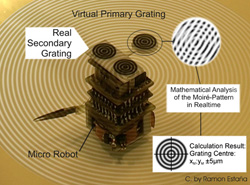Global Positioning comes to the nano domain
Precision is the name of the game in the nanotechnology race. A bold R&D project funded by the Information Society Technologies (IST) Programme targeted the creation of microrobots capable of operating in the nano domain. The engineers leading the project understood that it was crucial to have accurate, immediate feedback about the exact position of the microrobots. Whereas typical Global Positioning System (GPS) equipment is accurate to within one meter, the University of Karlsruhe had to construct a system accurate to within one micrometer. They accomplished this feat by taking advantage of the Moire optical effect that arises when one image is superimposed on another. The Micro Positioning System (MPS) captures images of a specially shaped grid affixed to the microrobot using a Charge Coupled Device (CCD) camera. A second virtual grid is generated by the MPS software and the combination of the two grids produces the Moire fringes. The image processing component of the MPS software then solves a system of mathematical equations to determine the object's position to within one micron. Apart from exceptional accuracy, the MPS also boasts near real-time response at two-tenths of a second. In addition, it has the capacity to simultaneously calculate the position of up to 30 separate objects. Finally, great care was taken to ensure that the interface between the user and the MPS software is user-friendly. The University of Karlsruhe has applied for a patent for the MPS and seeks opportunities to customise the MPS for use in other applications.







